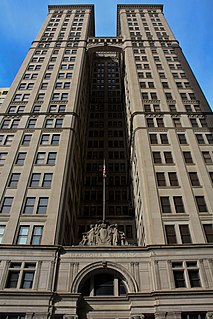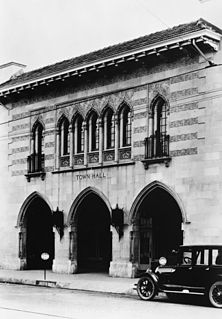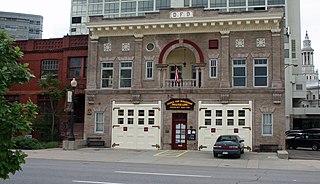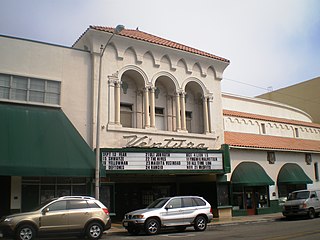
The Magnolia Hotel is a 29-story, Beaux-Arts style, upscale hotel in the Main Street District of downtown Dallas, Texas, that for many years was the tallest building in the state after surpassing the Adolphus Hotel. The structure is a Dallas Landmark and is listed on the National Register of Historic Places.

The Brown Palace Hotel and Spa, Autograph Collection is a historic hotel in Denver, Colorado, United States. It is listed on the National Register of Historic Places and is the second-longest operating hotel in Denver. It is one of the first atrium-style hotels ever built. It is now operated by HEI Hotels and Resorts, and joined Marriott's Autograph Collection Hotels in 2012. The hotel is located at 321 17th Street between 17th Street, Broadway and Tremont Place in downtown Denver behind the Republic Plaza. The main entrance door is on Tremont Place.

The Denver Civic Center is a civic center area that includes two parks surrounded by government and cultural buildings and spaces. Civic Center is located in central Denver, Colorado, on the south side of Downtown Denver. Much of the area is a historic district which was listed on the National Register of Historic Places in 1974. A somewhat smaller area was designated a U.S. National Historic Landmark in 2012 as one of the nation's finest examples of the City Beautiful movement of civic design. Denver Civic Center lies partially within the north end of an official Denver neighborhood also named Civic Center. It includes the Colorado State Capitol building, in the west end of Denver's official Capitol Hill neighborhood, and it includes a few buildings in the south end of Denver's Central Business District.

There are more than 1,500 properties and historic districts in Colorado listed on the National Register of Historic Places. They are distributed over 63 of Colorado's 64 counties; only the City and County of Broomfield has none.

Baker is a neighborhood in Denver, Colorado, United States.

The Villard Houses is a historic landmark at 455 Madison Avenue between 50th and 51st Street in Manhattan, New York City. The building was constructed in 1884, designed by architect Joseph M. Wells of McKim, Mead and White in the Renaissance Revival style. It is listed on the National Register of Historic Places and is a New York City designated landmark.

Jules Jacques Benois Benedict was one of the most prominent architects in Colorado history, whose works include a number of well-known landmarks and buildings listed on the National Register of Historic Places.

The Denver Firefighters Museum is a museum in downtown Denver, Colorado, United States. A nonprofit institution 501 (C) (3), it consists of an 11,000-square-foot (1,000 m2) facility housing four galleries that explore the history of firefighting in Denver. Established in 1978, it is located in the 1909-built former Fire Station No. 1, a building that is a Denver Landmark and has been listed on the National Register of Historic Places.
This is a list of the National Register of Historic Places listings in Downtown Denver, Colorado.
Frederick Sterner (1862–1931) was a British-born American architect, who designed large residential and commercial buildings in Colorado and New York City. Many of his structures are listed on the National Register of Historic Places.
Alan Berney Fisher was an American architect based in Denver, Colorado, working primarily for the firm of Fisher & Fisher founded by his father. He was active in historic preservation in the state.

Frank E. Edbrooke, also known as F.E. Edbrooke, was a 19th and early 20th century architect in Denver, Colorado who has been termed the "dean" of Denver architecture. Several of his surviving works are listed on the National Register of Historic Places including Brinker Collegiate Institute, built in 1880 and NRHP-listed in 1977.

William Ellsworth Fisher was an architect who founded the Denver, Colorado firm that became Fisher & Fisher.

John James Huddart (1856–1930), known usually as John J. Huddart, was a British born and trained architect who practised out of Denver, Colorado in the United States. At the end of the Nineteenth century he was one of Denver's leading architects, known for his work on public buildings and as a courthouse architect. His practice lasted from 1882 to 1930 and commissions included Charles Boettcher House in Denver, Colorado's Fort Morgan State Armory, Denver's Filbeck Building, and six of Colorado's county courthouses.

The Ventura Theatre is a historic live concert venue in downtown Ventura, California. This was "the only luxury theatre built in Ventura County in the 1920s in the "style of the great movie palaces." The lavish, elegant interior of gilt and opulence was originally designed by Robert E. Power Studios of San Francisco and has been restored. The theatre with a capacity of 1,150 and a flanking office building were designed by architect L. A. Smith in the Spanish Colonial Revival architecture that was favored by architects of motion picture theaters during the 1920s.

Frederick Carl Eberley was a prominent architect in Denver, Colorado. His work included the Barth Hotel (1882). He is also credited with Kopper's Hotel and Saloon, also known as the Airedale Building, added to the National Register of Historic Places in 1999. Eberley lived in the Schulz-Neef House, built in 1881 at 1739 E. 29th Avenue, for a time after German immigrant R. Ernst Schulz, a bookkeeper at the German National Bank and real estate investor for whom it was built. Eberley later lived at 29th Avenue and Gilpin Street. Eberley was a German immigrant and his commission for the Kopper's Hotel and Saloon came from a fellow German immigrant. His other work includes Colorado State Armory, Blatz Brewery, Colorado Bakery & Saloon, and Groussman Grocery.
Merrill H. Hoyt was a prominent American architect, business man and leader in the building design community of Denver, Colorado from 1910 to 1933.
Walter Rice, also known as Walter L. Rice (1866–1930), was an American architect, inventor, and engineer. He made a career as an architect in Denver, Colorado, particularly for the design of apartment buildings. Several of his buildings are designated National Register of Historic Places. He patented inventions for automobiles.
The Tilden School for Teaching Health operated from 1916 to 1931 as a private residential teaching institution and sanitarium that offered patients an alternative to the standard medical practices of the day. Located in Denver, Colorado, the school was established to teach and promote the medical theories of its founder, Dr. John Henry Tilden.













